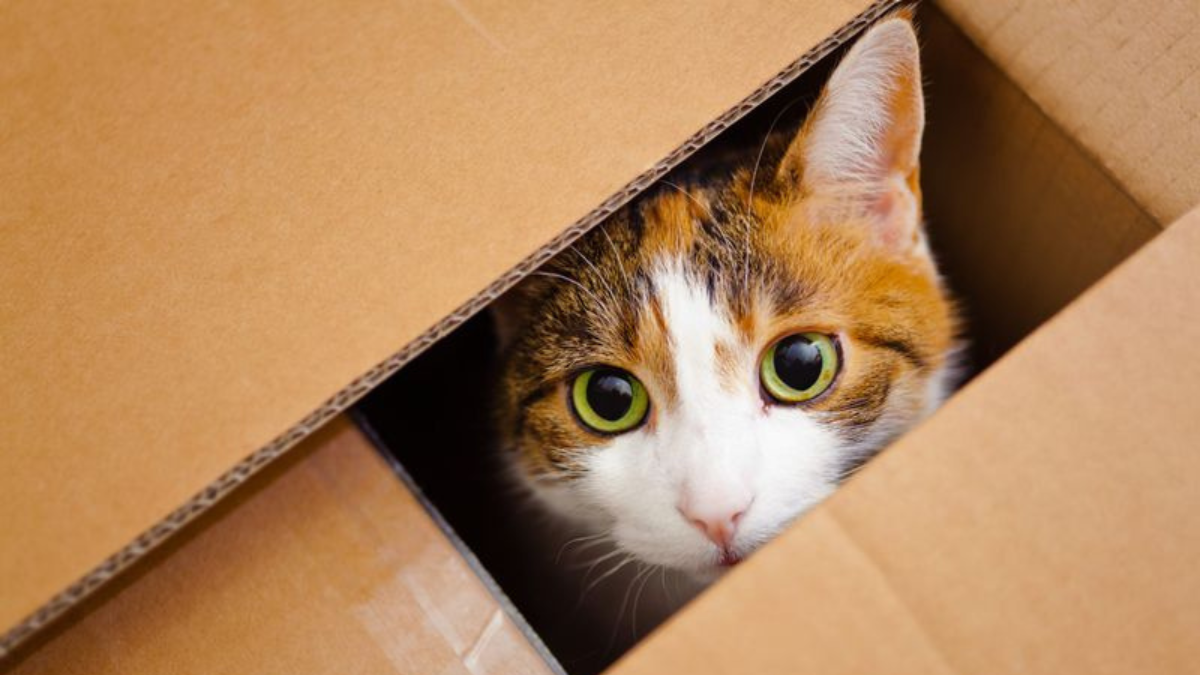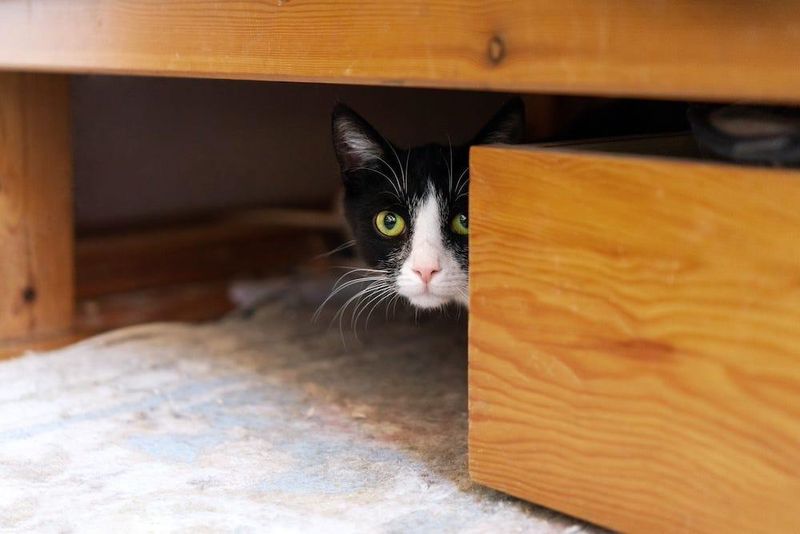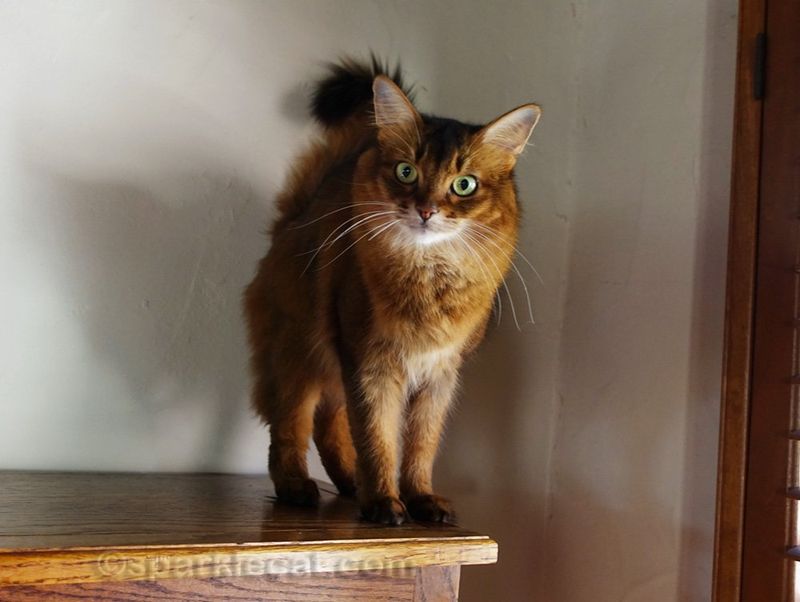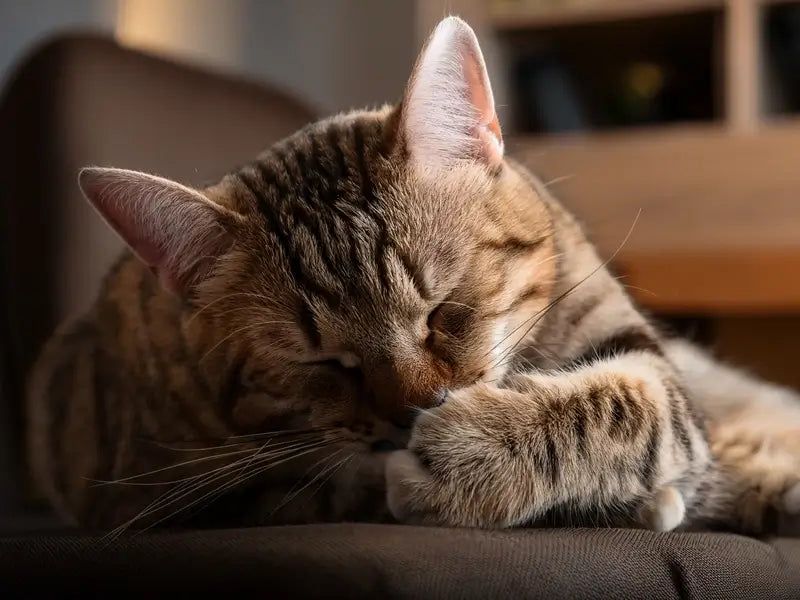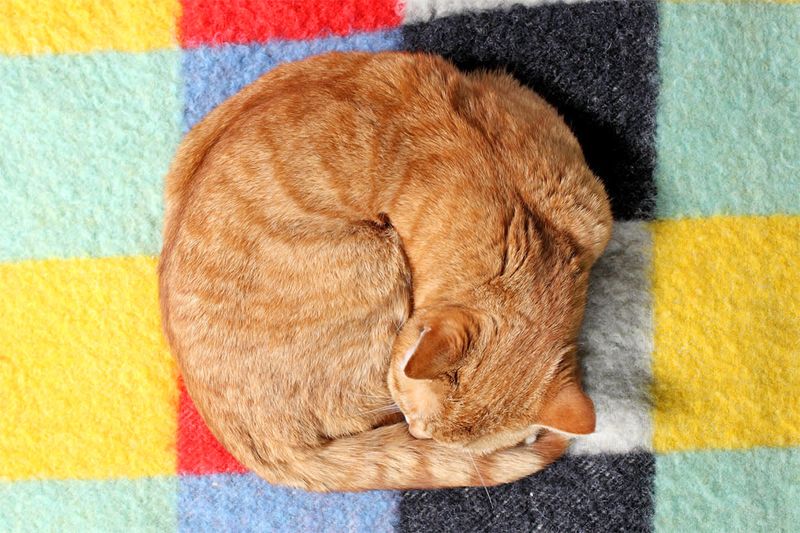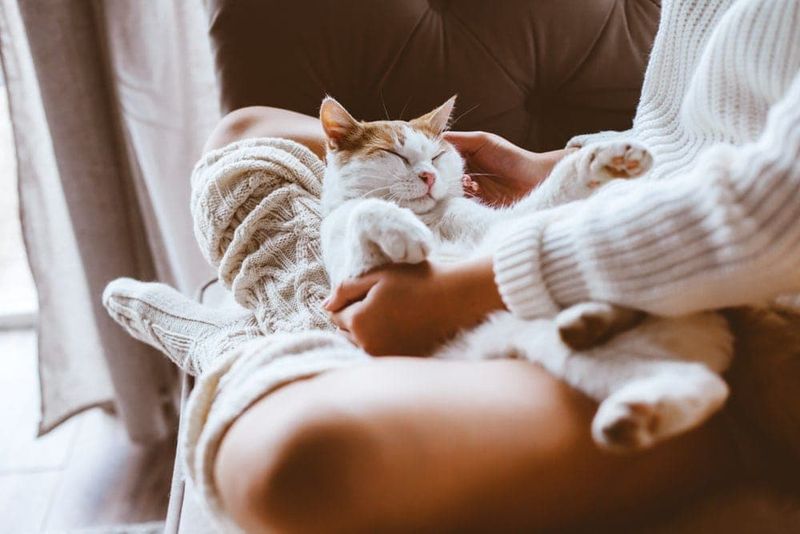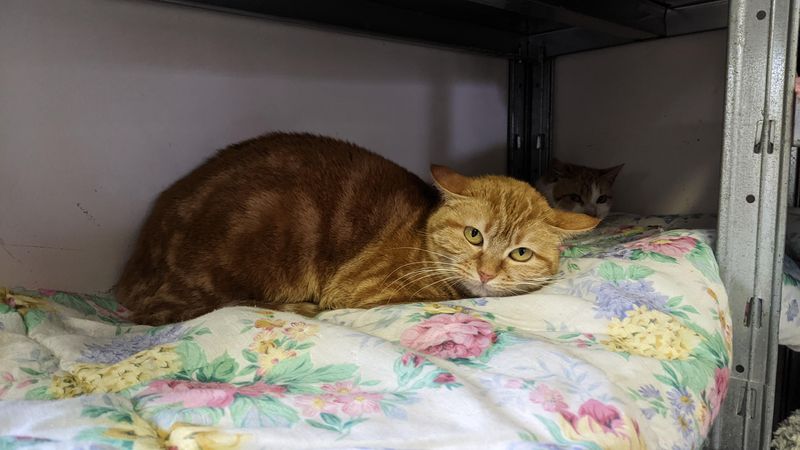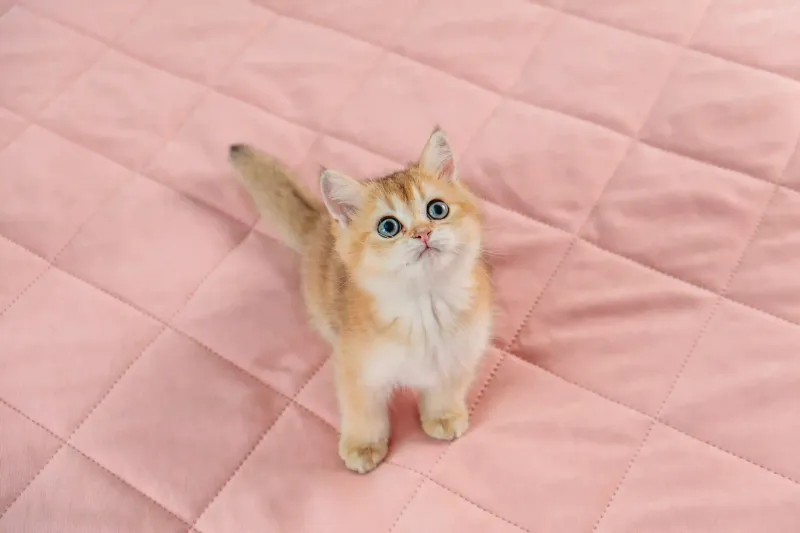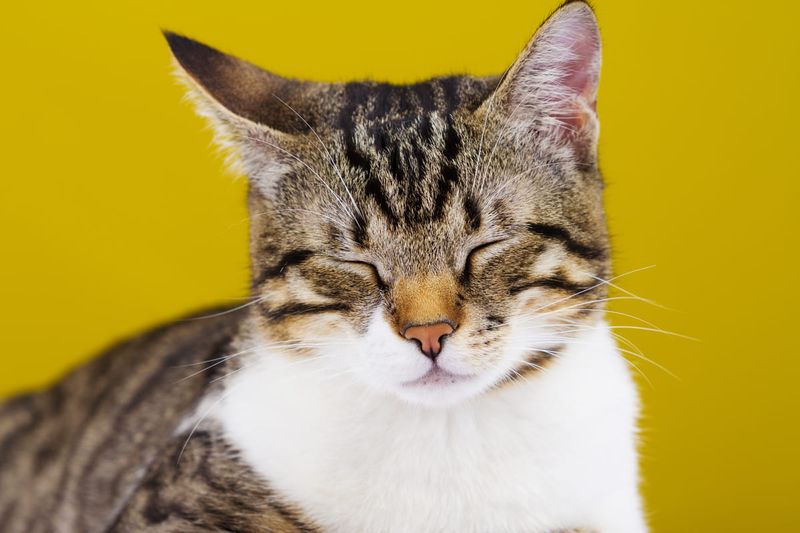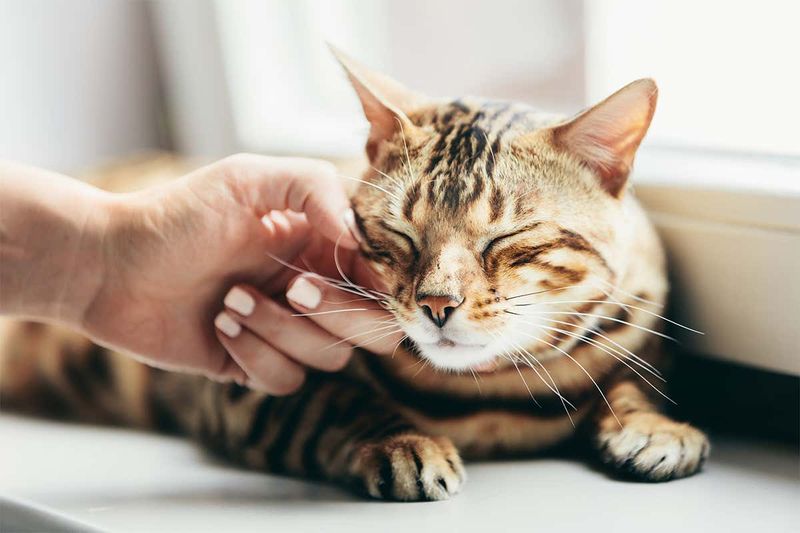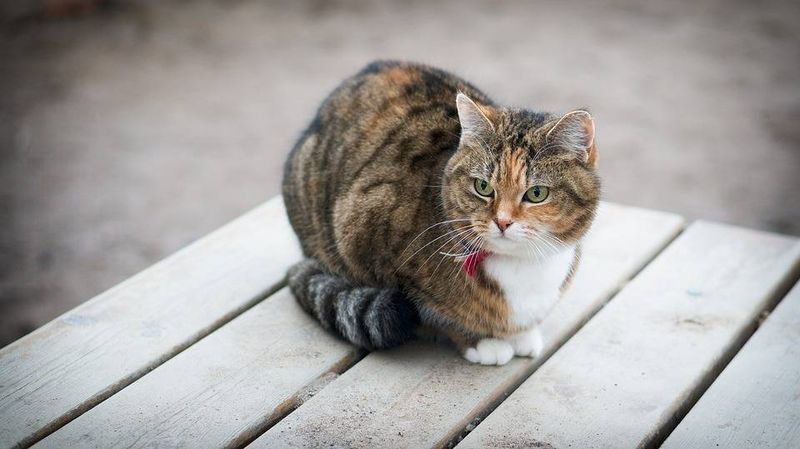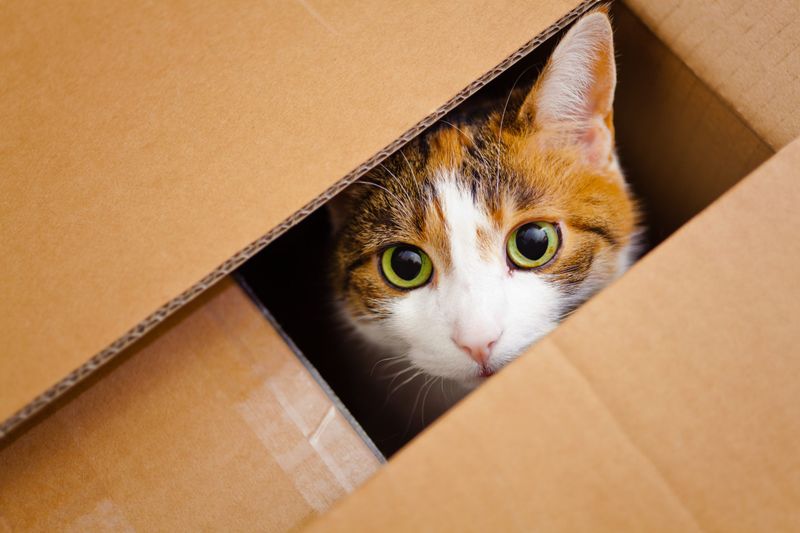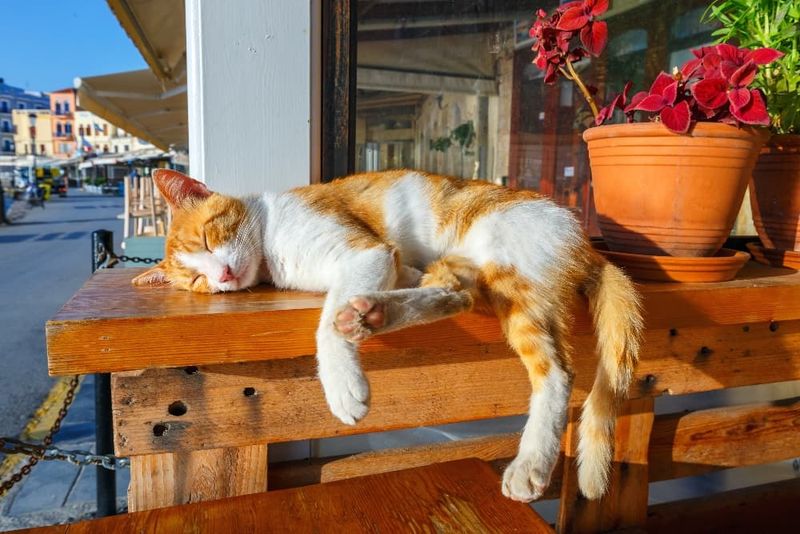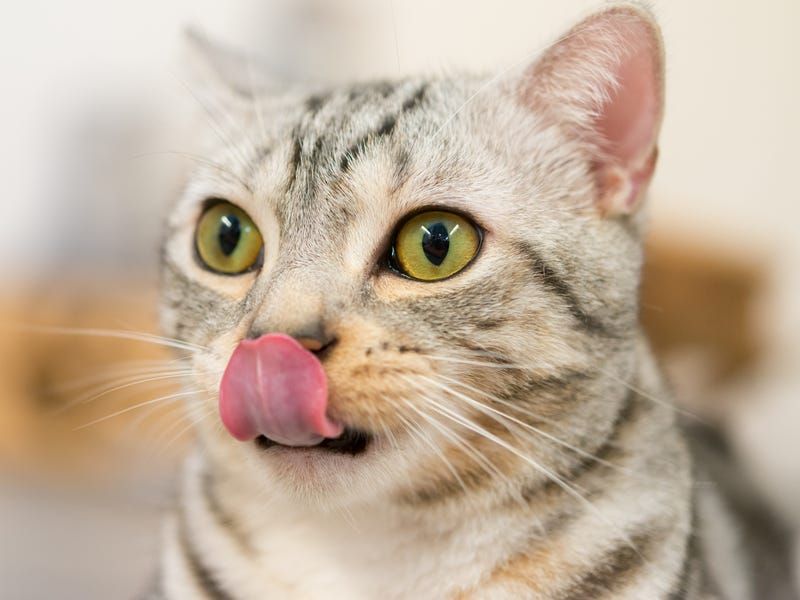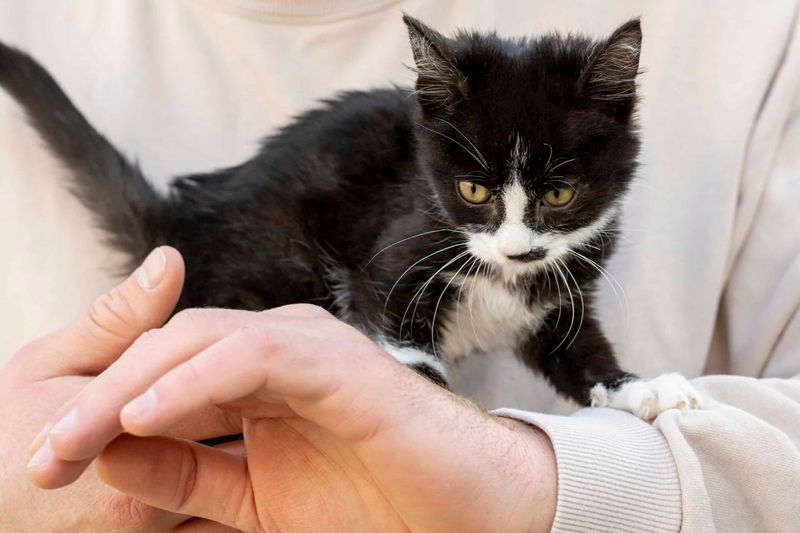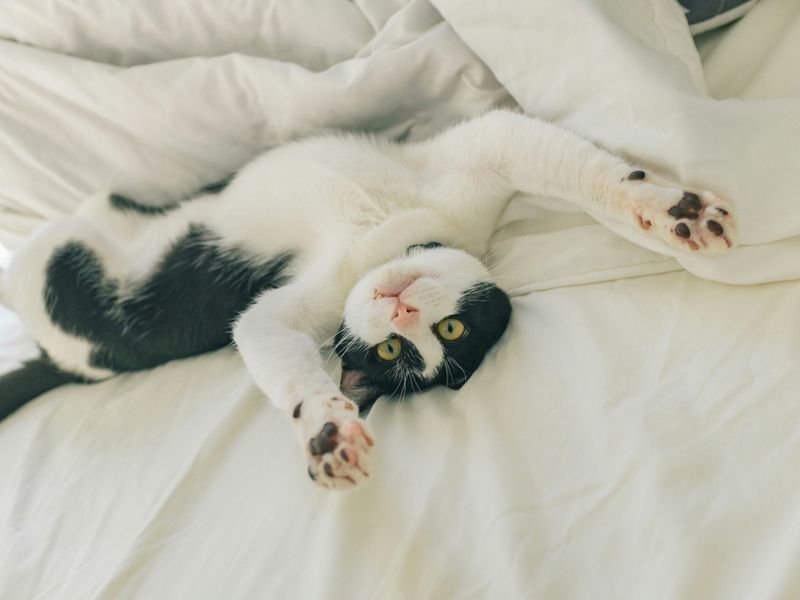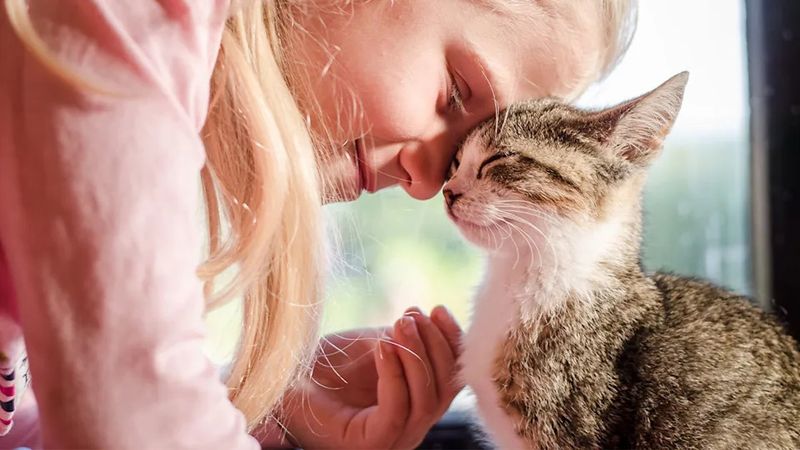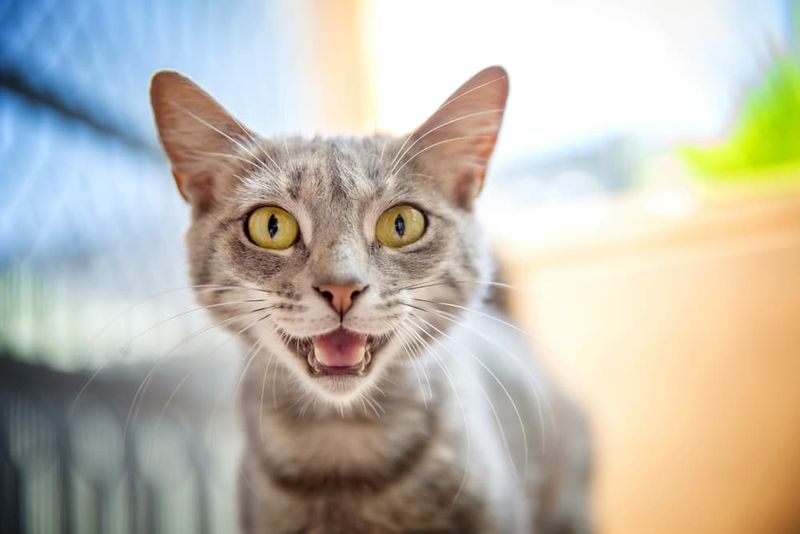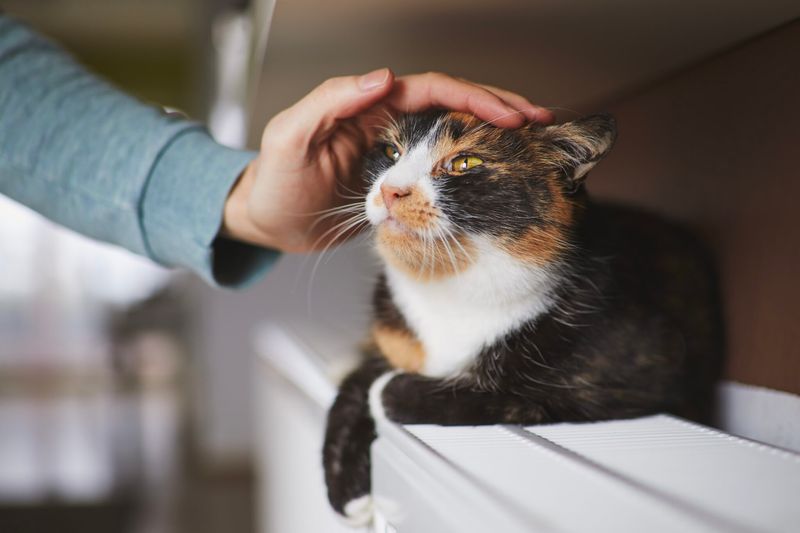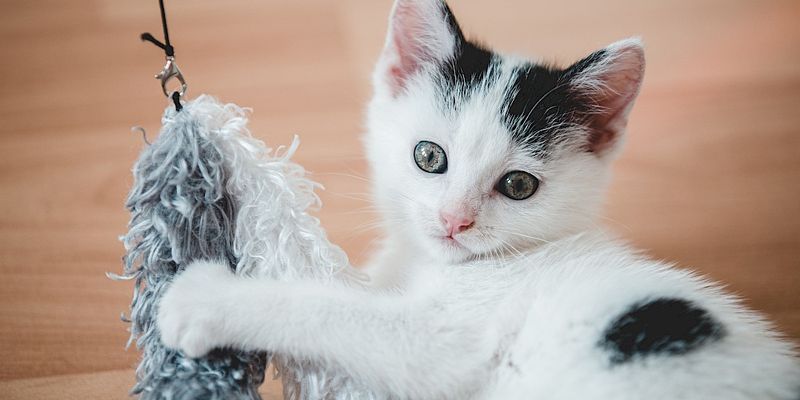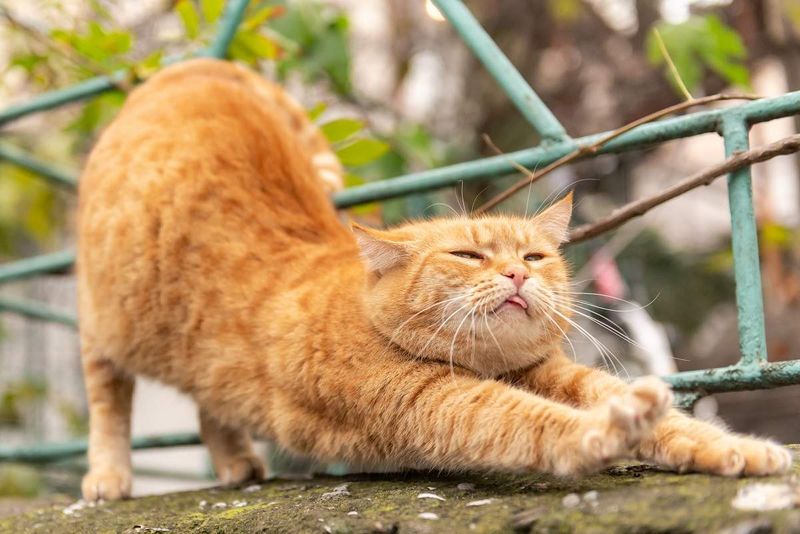📖 Table of Content:
- 1. Hiding Under Furniture
- 2. Seeking High Ground
- 3. Grooming Excessively
- 4. Curling Into Tight Balls
- 5. Seeking Their Human’s Lap
- 6. Retreating to Their Carrier
- 7. Kneading Soft Surfaces
- 8. Slow Blinking at Trusted Humans
- 9. Purring Through Fear
- 10. Wrapping Tail Around Their Body
- 11. Seeking Small, Enclosed Spaces
- 12. Seeking Sunbeams or Warm Spots
- 13. Licking Their Nose Repeatedly
- 14. Seeking Out Familiar Routines
- 15. Sleeping Near Their Human
- 16. Gentle Head-Butting
- 17. Chirping or Trilling Softly
- 18. Pressing Against Vertical Surfaces
- 19. Carrying or Gathering Toys
- 20. Slow, Deliberate Stretching
Cats may seem independent, but when they’re scared, they need comfort just like we do. Whether startled by a loud noise, spooked by a stranger, or terrified by a vacuum cleaner, our feline friends have unique ways of soothing themselves. Understanding these behaviors helps us support our cats through frightening experiences and strengthens the bond we share with them.
1. Hiding Under Furniture
Cats instinctively seek small, enclosed spaces when frightened. The dark, tight area under beds, couches, or cabinets creates a secure fortress where predators can’t easily reach them.
Your cat feels protected with solid barriers above and around them, giving them time to calm their racing heart. Some cats may stay hidden for hours until they’re convinced the danger has passed.
Many cats have favorite hiding spots they return to repeatedly when scared, showing they remember where they felt safe before.
2. Seeking High Ground
When threatened, cats often climb to elevated positions like bookshelves, cat trees, or refrigerator tops. This height advantage taps into their wild instincts, where elevation meant safety from ground predators.
From these high perches, cats can survey their surroundings while feeling less vulnerable. The vertical escape provides both physical distance from the scary stimulus and a psychological sense of control.
Many cat owners notice their frightened pets will remain on these high spots for extended periods, carefully watching to ensure the threat has truly disappeared.
3. Grooming Excessively
Self-grooming acts as a natural stress reliever for frightened cats. The repetitive licking motion releases endorphins in their brain, creating a calming effect similar to how humans might bite their nails when anxious.
You might notice your cat frantically cleaning areas they’ve already groomed moments before. This displacement behavior helps redirect their nervous energy into something familiar and soothing.
Cats particularly focus on their face, paws, and chest areas when stress-grooming. The behavior serves as both a comfort mechanism and a way to remove any scents that might attract predators.
4. Curling Into Tight Balls
A frightened cat will often transform into a perfect furry circle, tucking their head, paws, and tail close to their body. This protective posture minimizes their exposed surface area, shielding vital organs from potential threats.
The tight ball position also conserves body heat, providing physical comfort during stress. Many cats will find a corner or small space to curl up in, doubling their sense of security.
Watch for subtle trembling or twitching tail tips even while curled up – signs your cat is still processing their fear while seeking comfort in this instinctual position.
5. Seeking Their Human’s Lap
Despite their independent reputation, many cats rush to their trusted humans when frightened. Your familiar scent and heartbeat create a living safety zone for your scared feline friend.
Some cats who normally avoid laps become surprisingly clingy after a scare. They might press against you, knead your legs, or tuck their head under your hand seeking reassurance.
The warmth and steady breathing of a human companion help regulate the cat’s elevated heart rate. This physical connection reminds them they’re protected by their most reliable ally in the household.
6. Retreating to Their Carrier
Cats who have positive associations with their carriers often seek them out when scared. The enclosed space with familiar scents creates a portable safe room where they can process their fright.
Smart cat owners leave carriers out with comfortable bedding inside, making them inviting retreats rather than just transportation tools. The carrier becomes a personal sanctuary your cat can count on during thunderstorms or when visitors overwhelm them.
Some cats will enter their carriers and face the back wall, effectively shutting out the scary world until they feel brave enough to emerge again.
7. Kneading Soft Surfaces
The rhythmic pushing motion of a cat’s paws against soft blankets or pillows connects them to their earliest comfort memories. This kneading behavior, developed as kittens to stimulate milk flow from their mother, becomes a self-soothing technique after a frightening experience.
The repetitive motion releases tension while the soft texture provides sensory comfort. Many cats purr while kneading, showing how effectively this behavior calms their nervous system.
Your cat might seek out specific textures – like fleece, wool, or even your favorite sweater – that feel particularly comforting under their sensitive paw pads.
8. Slow Blinking at Trusted Humans
After the initial panic subsides, cats often establish eye contact with their humans and perform slow, deliberate blinks. This subtle communication signals they’re seeking reassurance and ready to accept comfort.
Cat behaviorists call these “kitty kisses” – a vulnerable gesture showing trust during a time when they feel insecure. Responding with your own slow blinks creates a calming conversation that helps your cat regulate their emotions.
The gentle eye contact serves as a bridge back to normalcy after a frightening event. Your cat is essentially asking, “Are we safe now?” through this intimate visual exchange.
9. Purring Through Fear
Contrary to popular belief, purring doesn’t always signal happiness. Cats often purr when scared as a self-soothing mechanism that literally vibrates stress away.
The low-frequency vibrations of purring have been shown to promote healing and reduce stress hormones in cats. Your frightened feline might purr loudly while still showing other signs of fear, like dilated pupils or flattened ears.
This self-comforting purr has a different quality than a content purr – it’s often louder and more persistent. The vibrations work like an internal massage, helping to calm your cat’s nervous system after a scare.
10. Wrapping Tail Around Their Body
A frightened cat often wraps their tail tightly around their body like a protective scarf. This self-hugging gesture serves multiple comfort purposes beyond just the obvious physical protection.
The wrapped tail position covers vulnerable areas while providing tactile reassurance through self-touch. Many cats will tuck the tail tip under their paws or around their face, creating a complete circle of self-comfort.
This posture helps cats feel more secure by making themselves smaller and more contained. The physical pressure of their own tail against their body provides gentle, constant reassurance until the fear subsides.
11. Seeking Small, Enclosed Spaces
Boxes, drawers, and small closets become magnetic safe havens for scared cats. These confined spaces create boundaries on all sides, reducing the directions a potential threat could approach from.
The snug fit against their body provides constant tactile feedback that they’re protected. Many cats prefer spaces just barely big enough for their bodies, as the slight pressure creates a swaddling effect.
Your cat might squeeze into surprisingly small spaces when frightened – behind books on shelves, inside partially open drawers, or even empty paper bags. These improvised shelters offer immediate comfort through their enclosed, den-like qualities.
12. Seeking Sunbeams or Warm Spots
Heat provides natural comfort to stressed cats. After a scare, many felines gravitate toward sunny windowsills, heating vents, or warm electronics like laptop computers.
The warmth relaxes tense muscles and triggers positive associations with safety. Your cat might stretch out fully in these warm spots, allowing the heat to penetrate their fur and soothe their nervous system.
Some cats develop specific warm-spot preferences they return to repeatedly when frightened. These thermal comfort zones become reliable self-care stations your cat seeks instinctively after any alarming experience.
13. Licking Their Nose Repeatedly
The quick, repetitive tongue flicks across their nose or lips serve as a self-calming mechanism for frightened cats. This behavior releases tension while giving them something familiar to focus on besides their fear.
Nose-licking also helps cats process scents more effectively by moistening their nasal area. Your cat is essentially gathering more information about the potential threat while self-soothing.
Watch for this subtle behavior – it often precedes other comfort-seeking actions. The rhythmic licking helps regulate breathing and heart rate, gradually bringing your cat back to a calmer state after being startled.
14. Seeking Out Familiar Routines
After the initial shock subsides, scared cats often attempt to resume normal activities like requesting meals or playtime. This return to routine helps them reestablish a sense of normalcy and control.
Your cat might suddenly become interested in their food bowl or favorite toy after hiding from a scare. These familiar activities serve as emotional anchors, reminding them that their world remains predictable despite the frightening event.
Supporting these routine-seeking behaviors helps your cat recover faster. When they initiate these normal interactions, they’re actively self-soothing by connecting with the reliable patterns that define their safe, everyday life.
15. Sleeping Near Their Human
Cats who normally maintain their independence often become surprisingly clingy sleepers after a scare. They might press against your legs, sleep on your pillow, or curl up directly on your chest when they normally wouldn’t.
The sound of your heartbeat and breathing creates a living white noise machine that masks potentially threatening sounds. Your familiar scent and body warmth reinforce their sense of safety throughout vulnerable sleep cycles.
This closeness during rest allows them to fully relax knowing you’re on guard. Many cats will specifically position themselves where they can feel or hear your breathing while they sleep off their fright.
16. Gentle Head-Butting
Once their intense fear begins to subside, many cats initiate head-butting or bunting against their humans or other pets. This behavior transfers their scent to you while simultaneously collecting your reassuring scent on their sensitive facial glands.
The gentle pressure of head-butting also provides physical comfort through touch. Your cat is essentially saying, “I need to reconnect with you after that scary experience” through this affectionate gesture.
Responding with gentle scratches around their cheeks and chin encourages this comfort-seeking behavior. The exchange helps rebuild their confidence while strengthening your bond after they’ve experienced something frightening.
17. Chirping or Trilling Softly
The distinctive chirping or trilling sounds some cats make after a scare aren’t random – they’re self-soothing vocalizations that help regulate breathing and release tension. These gentle sounds vibrate through their throat and nasal passages, creating a calming internal massage.
Mother cats use these same sounds to reassure kittens, so your adult cat is essentially self-parenting when frightened. The soft vocalizations often coincide with other comfort-seeking behaviors like kneading or seeking physical contact.
Responding with your own quiet, gentle voice encourages this natural coping mechanism. Your cat is literally talking themselves down from their fear response through these musical little sounds.
18. Pressing Against Vertical Surfaces
Frightened cats often seek walls or furniture sides to press their bodies against. This behavior provides immediate tactile feedback that at least one side of their body is protected from potential threats.
The firm pressure against their side creates a secure boundary they can physically feel. Many cats will slide along walls or furniture edges when moving through a space after being scared.
Some cats take this further by wedging themselves into corners where two walls meet, maximizing the protected surface area around their bodies. This natural comfort-seeking behavior explains why scared cats rarely cross open spaces directly after a frightening experience.
19. Carrying or Gathering Toys
Some cats collect their favorite toys after a scare, carrying them to their safe space or gathering them close. This behavior mimics how mother cats move kittens to safety and provides emotional comfort through familiar objects.
The toys carry the cat’s own scent and positive associations with play and security. Your cat might vocalize while carrying these comfort objects, similar to how they would call to kittens.
This toy-gathering serves as a distraction from fear while giving them a sense of control. By moving their cherished possessions to their safe zone, they’re actively creating a comfortable environment where they can begin to relax again.
20. Slow, Deliberate Stretching
As cats begin to recover from fear, they often perform extended, exaggerated stretches. These deliberate movements release physical tension stored in their muscles during the fight-or-flight response.
The stretching literally resets their body posture from the contracted, defensive position they assumed when scared. You’ll notice these stretches look more intentional and prolonged than their usual wake-up stretches.
This behavior signals they’re transitioning back to a normal state. The stretching increases blood flow to muscles that tensed during fear, helping to flush stress hormones from their system while providing a gentle full-body relief that speeds their emotional recovery.
